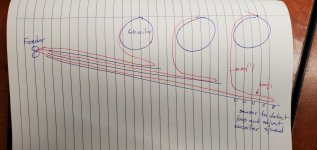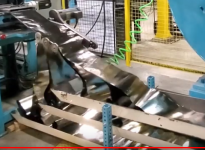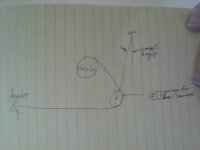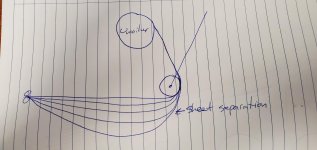This is turning into a great thread. Thank you guys for contributing.
I'm going to try to catch up here all at once.
Drbitboy, you are correct. The trays are set up to overfeed. As you have stated previously, there is an accumulation of error. The operators can use a push button to skip up to 5 feeds to use up excess material in the trays while it's running. If left unchecked the operators will have to manually deal with extra material 2-3 times per coil. Also, there are 5 sheets per coil and 3 coils feeding the cutting section.
GaryS I do think the loop is the best way to go however there are a few challenges. Having 5 sheets per coil leads to sheet separation as the material is uncoiled. The outer sheet has a larger circumference than the inner sheets. This also causes an issue for any roller or dancer arm set up. In order to create a loop the uncoilers would have to be raised up which would make it to difficult for the operators to load or a pit would have to be installed which is too expensive.
It is messy but it does work. You're correct GaryS, there is a laser distance sensor that measures the circumference which offsets the speed as the coil gets smaller. The goal is to run the feeder as fast as possible with the highest accel. When too high, the sheets will tear and/or the feeder will jam. The speed and reaction time of the uncoiler is tuned for a wide range of feed lengths. When the feeds are small I'm able to increase the velocity and acc of the servo. Long feeds require more material in the trays and that's when the uncoilers have to keep feeding which is why they seem to be going too fast.
You are correct GaryS, there are 3 uncoilers. The oscillation is meant to relax and line up the sheets prior to and during entry into the feeder. There are no brakes. Stopping/starting the uncoilers would impact the cycle time too much.
Unfortunately, I can't reveal too much of the machine. We build these in-house and don't want competitors to see anything.
L D[AR2,P#0.0] The machine is working but the operator has to constantly monitor the trays. They have to skip feeds (stop the uncoiler for up to 5 feeds) or wait till there is too much material in the trays, then stop the machine and manually adjust the amount in the trays. This impacts cycle time. While the machine is running, the operator is assembling the product. I consider my programming skill to be at an intermediate level. Unfortunately, I have no mentor to learn from or discuss programming with and I'm finding that my development has slowed. I wanted to see how other programmers would approach this.
parky As mentioned above, sheet separation will prove difficult with dancer arms. They work well with continuous feed setups or slow intermittent feeds.
I do have an idea for trays that I'm going to pitch. See pic. Thoughts?
Thanks again guys.









